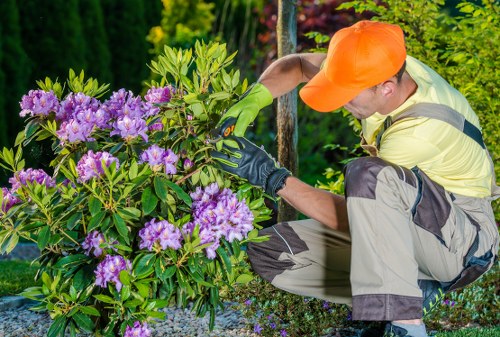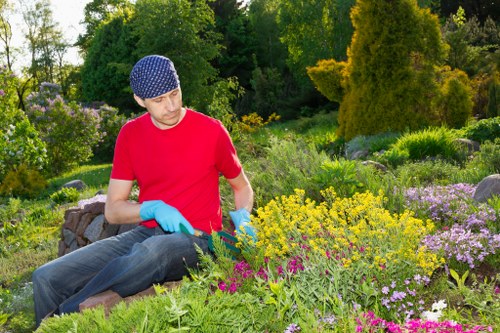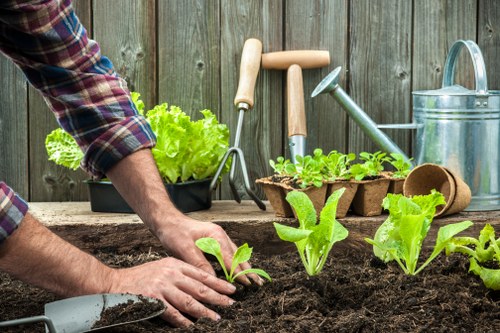Transforming Outdoor Spaces: Expert Landscaping in Garden Landscapes

Landscaping in garden landscapes plays a pivotal role in enhancing the beauty, functionality, and value of outdoor spaces. Whether you're aiming to create a serene retreat, a vibrant entertaining area, or a sustainable ecosystem, effective landscaping can make all the difference.
In this comprehensive guide, we'll explore the various aspects of garden landscaping, from design principles and plant selection to sustainable practices and maintenance tips. Whether you're a seasoned gardener or a homeowner looking to revamp your yard, this article offers valuable insights to help you achieve your landscaping goals.
Understanding the fundamentals of landscaping is crucial for creating a garden that not only looks stunning but also meets your specific needs and preferences. Let's delve into the essential components that make up a successful garden landscape.
The Importance of Landscaping in Garden Landscapes

Landscaping extends beyond mere aesthetics; it encompasses the strategic planning and implementation of various elements to create a harmonious outdoor environment. Here are some key reasons why landscaping is essential:
- Enhanced Curb Appeal: A well-designed garden landscape significantly boosts the visual appeal of your property, making it more inviting and attractive.
- Increased Property Value: Quality landscaping can increase the market value of your home, providing a worthwhile investment for the future.
- Functional Outdoor Space: Landscaping transforms your yard into a functional space for relaxation, entertainment, and recreational activities.
- Environmental Benefits: Thoughtful landscaping contributes to environmental sustainability by promoting biodiversity, reducing erosion, and improving air quality.
- Personal Satisfaction: Creating a beautiful garden landscape offers a sense of accomplishment and enhances your overall well-being.
By understanding these benefits, you can better appreciate the role of landscaping in shaping your garden into a space that reflects your lifestyle and values.
Design Principles for Effective Garden Landscaping

Effective garden landscaping is rooted in solid design principles that ensure balance, harmony, and functionality. Here are the key design elements to consider:
- Balance: Achieving balance involves distributing visual weight equally across your garden. This can be symmetrical, asymmetrical, or radial, depending on your aesthetic preference.
- Unity: Unity ensures that all elements within the garden work together cohesively. Consistent color schemes, materials, and plant types contribute to a unified look.
- Scale and Proportion: Selecting plants and structures that are proportionate to the size of your garden helps maintain a harmonious appearance.
- Focal Points: Incorporating focal points, such as a striking tree, a water feature, or a sculpture, draws attention and adds interest to the garden.
- Rhythm: Rhythm is created through the repetition of elements, such as plants, colors, or patterns, which guides the eye through the garden.
Applying these design principles will help you create a garden landscape that is not only beautiful but also functional and enjoyable.
Selecting the Right Plants for Your Garden Landscape

Choosing the appropriate plants is a critical aspect of landscaping in garden landscapes. The right selection can enhance the visual appeal, provide structure, and ensure the sustainability of your garden. Consider the following factors when selecting plants:
- Climate Compatibility: Select plants that thrive in your local climate to ensure they remain healthy and vibrant.
- Soil Type: Understanding your soil composition helps in choosing plants that will grow well in your specific conditions.
- Sunlight Exposure: Different plants require varying amounts of sunlight, so assess the light levels in different parts of your garden.
- Water Requirements: Opt for plants that match your watering capabilities to promote sustainability and reduce maintenance.
- Maintenance Levels: Consider the amount of time and effort you're willing to invest in maintaining your garden when selecting plants.
By carefully selecting plants that align with these factors, you can create a thriving and low-maintenance garden landscape.
Incorporating Hardscaping Elements

Hardscaping refers to the non-living components of your garden that provide structure and functionality. Integrating hardscaping elements can enhance the overall design and usability of your outdoor space. Key hardscaping elements include:
- Paths and Walkways: Define movement within your garden and guide visitors through different areas.
- Patios and Decks: Create designated spaces for seating, dining, and entertaining.
- Water Features: Add tranquility and visual interest with fountains, ponds, or waterfalls.
- Retaining Walls: Manage slopes and prevent erosion while adding height and dimension to your garden.
- Outdoor Lighting: Illuminate pathways and highlight garden features to extend the usability of your space into the evening.
Incorporating these hardscaping elements can transform your garden into a functional and aesthetically pleasing outdoor living area.
Sustainable Landscaping Practices

Sustainability is becoming increasingly important in garden landscaping. Implementing eco-friendly practices not only benefits the environment but also ensures the longevity and resilience of your garden. Here are some sustainable landscaping tips:
- Native Plants: Use native species that are adapted to your local climate and soil, reducing the need for excessive watering and maintenance.
- Water Conservation: Incorporate irrigation systems that minimize water usage, such as drip irrigation, and collect rainwater for gardening needs.
- Composting: Create compost from garden waste to enrich the soil and reduce the need for chemical fertilizers.
- Organic Mulch: Apply organic mulch to retain soil moisture, suppress weeds, and improve soil health.
- Wildlife Habitat: Design your garden to support local wildlife by providing food, shelter, and water sources.
Adopting these sustainable practices contributes to a healthier ecosystem and a more resilient garden landscape.
Maintenance Tips for a Thriving Garden Landscape

Regular maintenance is essential to keep your garden landscape looking its best and functioning efficiently. Here are some maintenance tips to ensure your garden remains healthy and attractive:
- Pruning: Regularly prune plants and trees to remove dead or diseased branches and encourage healthy growth.
- Weed Control: Keep weeds at bay by manually removing them or using eco-friendly herbicides.
- Soil Health: Test and amend soil as needed to maintain optimal fertility and pH levels for your plants.
- Pest Management: Monitor for pests and implement integrated pest management strategies to protect your plants.
- Seasonal Clean-Up: Prepare your garden for different seasons by clearing debris, protecting plants from extreme weather, and adjusting care routines.
Consistent maintenance ensures that your garden landscape remains vibrant and continues to provide enjoyment year-round.
Choosing the Right Landscaping Professionals

While DIY landscaping projects can be rewarding, hiring professional landscapers can ensure that your garden landscape is expertly designed and maintained. Here are some tips for selecting the right landscaping professionals:
- Experience and Expertise: Look for landscapers with a proven track record and expertise in the specific areas you need.
- Check References and Reviews: Read testimonials and speak with previous clients to gauge the quality of their work.
- Assess Portfolio:
- Budget and Pricing:
- Communication and Understanding:
By carefully evaluating potential landscapers, you can partner with professionals who will bring your garden landscape vision to life.
Innovative Landscaping Trends

Staying updated with the latest landscaping trends can inspire new ideas and keep your garden landscape modern and appealing. Here are some current trends in garden landscaping:
- Vertical Gardens: Maximize space and add greenery with vertical planting systems, ideal for small or urban gardens.
- Edible Landscaping: Integrate fruits, vegetables, and herbs into your garden design for both beauty and utility.
- Sustainable Materials: Use eco-friendly materials such as recycled plastics, sustainably sourced wood, and permeable paving.
- Smart Irrigation Systems: Incorporate technology to automate and optimize watering schedules for efficiency.
- Outdoor Living Spaces: Extend your living areas outdoors with comfortable seating, kitchens, and entertainment setups.
Embracing these trends can enhance the functionality and aesthetic appeal of your garden landscape.
Conclusion: Creating Your Dream Garden Landscape

Landscaping in garden landscapes is a multifaceted endeavor that combines art, science, and sustainability. By understanding design principles, selecting the right plants, incorporating hardscaping elements, and maintaining your garden diligently, you can create a beautiful and functional outdoor space that reflects your personal style and meets your needs.
Whether you're starting from scratch or looking to enhance an existing garden, the key to successful landscaping lies in careful planning and thoughtful execution. Embrace creativity, prioritize sustainability, and enjoy the process of transforming your garden into a thriving landscape.
Ready to elevate your outdoor space? Contact us today to discuss how our expert landscaping services can help you achieve your dream garden landscape.